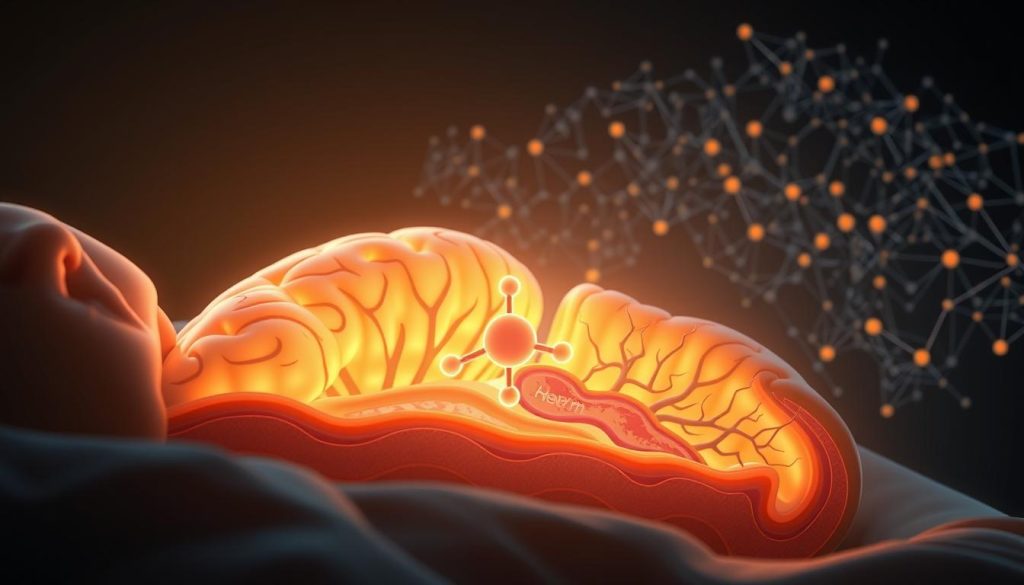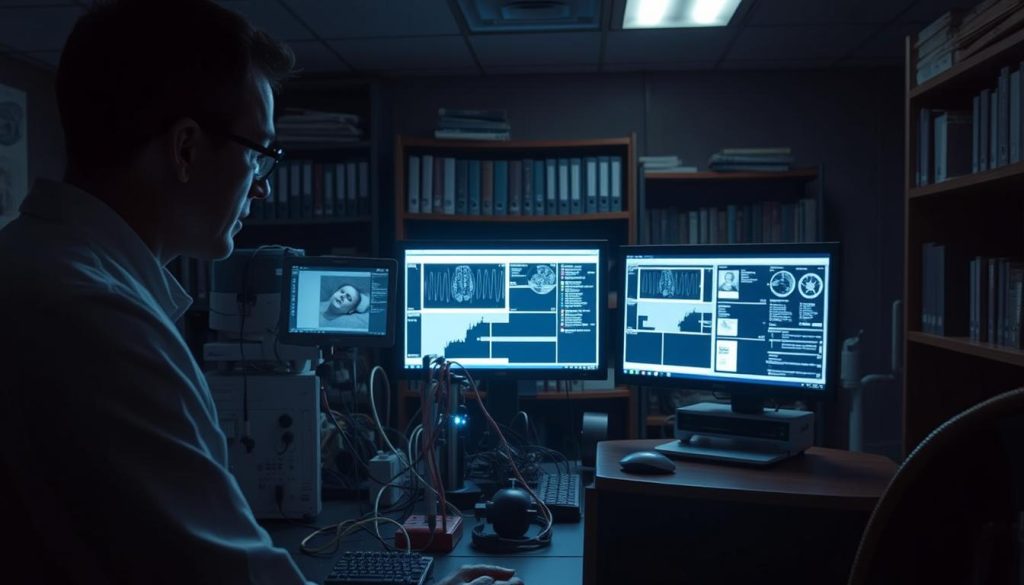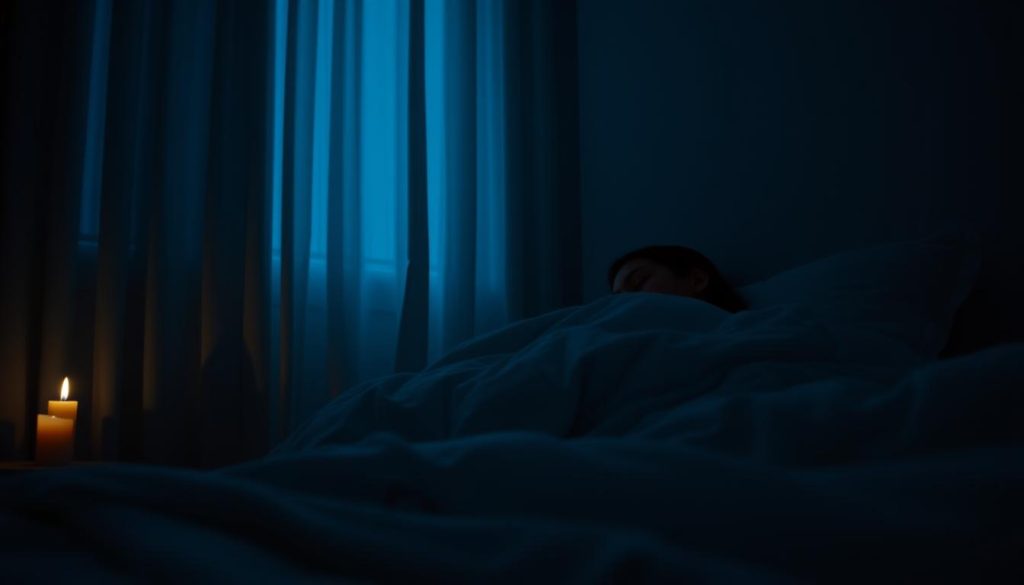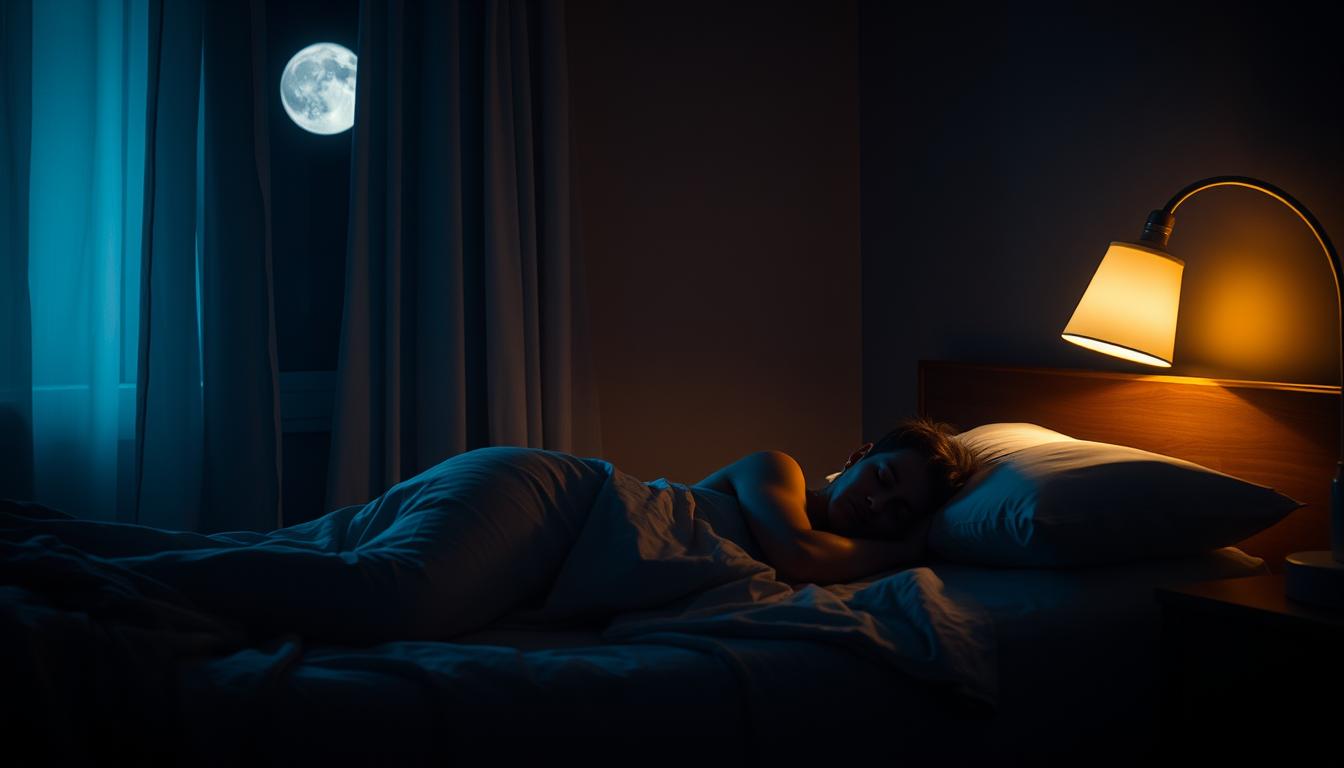Light plays a key role in regulating our internal clock. It influences when we feel awake and when we feel tired. For those with sleep apnea, this connection is even more critical.
Both natural and artificial sources can disrupt sleep patterns. Studies show that changes in light exposure alter sleep architecture. This can lead to breathing difficulties during rest.
Recent research highlights how the internal clock, set by light cues, impacts sleep health. Clinical studies and ambulatory PSG findings provide deeper insights. Real-life observations further support these findings.
This article explores the latest evidence. It also examines how current sleep regulation models might need reassessment. Understanding this link can help improve sleep quality for many.
Understanding the Role of Light in Sleep Regulation
The body’s internal clock relies heavily on external cues to function properly. One of the most influential factors is light. It acts as a primary signal, guiding when we feel awake and when we feel tired.
Natural light and darkness play a key role in controlling melatonin production. This hormone helps regulate the onset of rest. When it’s dark, melatonin levels rise, preparing the body for sleep. Brightness, on the other hand, suppresses this hormone, keeping us alert.
Research shows that the intensity and timing of light significantly affect rest quality. Studies in both labs and real-world settings highlight this connection. For example, bright light late in the evening can delay sleep onset, leading to shorter rest periods.
Understanding these mechanisms is crucial for developing healthier habits. By managing light cues, individuals can improve their daily rhythms and overall well-being.
Exploring Light Exposure and Sleep Apnea: What the Research Reveals
Recent studies shed light on the connection between environmental factors and rest quality. For individuals with breathing disruptions during rest, this link is particularly significant. Research highlights how external cues can influence nighttime patterns, leading to reduced rest quality.
One key finding is the role of timing. Late exposure to bright signals can delay rest onset, making it harder to fall asleep. This delay often results in shorter rest periods and more frequent disruptions. Such patterns are especially problematic for those with nighttime breathing issues.
Intensity also plays a crucial role. Studies show that brighter signals in the evening can suppress the hormone that promotes rest. This suppression can lead to fragmented rest and worsen breathing disturbances. Ambulatory PSG studies provide statistical evidence of these correlations.
Understanding these effects is essential for improving nighttime health. By managing external cues, individuals can enhance their daily rhythms and reduce rest disturbances. Future interventions can use this research to develop strategies for better rest quality.
The Science Behind Circadian Rhythms and Sleep Quality
Our daily rhythms are deeply influenced by external factors, particularly light. These rhythms, known as circadian cycles, regulate when we feel alert and when we feel tired. They are controlled by an internal clock located in the brain’s suprachiasmatic nucleus.
This clock processes signals from the environment, especially light cues. Natural sunlight during the day helps reset the internal timing system. In contrast, artificial sources at night can disrupt this process, leading to fragmented rest.
The Impact of Natural Versus Artificial Light
Natural light, with its high intensity during the day, has a positive effect on rest quality. It helps align the internal clock with the natural cycle of day and night. Early morning exposure can advance rest timing, making it easier to fall asleep at night.
Artificial light, especially in the evening, can delay the circadian phase. This delay often results in shorter rest periods and more frequent disruptions. Studies show that bright signals at night suppress the hormone that promotes rest, worsening breathing disturbances.
How Light Shapes the Body’s Internal Clock
The suprachiasmatic nucleus plays a key role in processing light cues. It sends signals to other parts of the body, regulating functions like hormone release and body temperature. When this system is disrupted, it can lead to irregular rest patterns.
Research highlights the importance of managing light exposure for better rest outcomes. For individuals with nighttime breathing issues, adjusting light cues can improve daily rhythms and reduce disturbances. Simple changes, like reducing artificial light in the evening, can make a significant difference.
How Light Impacts the Body’s Sleep Architecture
The timing and intensity of environmental cues significantly shape rest patterns. These cues influence distinct stages, such as REM and slow-wave sleep. Studies show that prior exposure can lead to quicker REM onset or longer slow-wave phases.
Melatonin suppression plays a key role in these changes. When external signals delay melatonin release, it disrupts the natural progression of rest stages. This can result in fragmented rest and reduced overall quality.

Early exposure to bright signals can advance rest timing, making it easier to fall asleep. Late exposure, however, delays the circadian phase, leading to shorter rest periods. These shifts can worsen breathing disturbances during rest.
Understanding these mechanisms is crucial for developing targeted interventions. By managing external cues, individuals can improve their rest architecture and reduce disruptions. This is especially important for those with nighttime breathing issues.
This article highlights the importance of aligning environmental signals with the body’s internal clock. Simple adjustments, like reducing artificial signals in the evening, can make a significant difference. These changes can enhance rest quality and overall well-being.
Clinical Insights from Ambulatory Field Studies
Ambulatory field studies provide valuable insights into how environmental factors influence rest patterns. These studies use real-world conditions to assess the impact of external cues on rest quality. Unlike controlled lab settings, ambulatory research captures the complexities of daily life.
Ambulatory PSG Findings and Research Methods
Ambulatory polysomnography (PSG) is a key tool in this research. It allows for continuous monitoring of rest parameters in natural settings. Wrist-based light sensors and actigraphy provide objective measurements of environmental signals and activity levels.
Findings from these studies reveal significant changes in rest continuity and rhythm modulation. For example, exposure to bright signals in the evening can delay rest onset and reduce overall quality. These insights are crucial for developing targeted interventions.
| Study | Key Findings | Implications |
|---|---|---|
| Study A | Evening light delays rest onset | Adjust light cues for better timing |
| Study B | Bright signals reduce rest quality | Limit artificial light at night |
| Study C | Actigraphy confirms rhythm disruptions | Use wearable devices for monitoring |
Real-life assessments offer unique advantages over lab conditions. They capture the variability of daily routines and environmental factors. However, they also present challenges, such as controlling for external variables.
These studies emphasize the importance of translating lab findings into real-world contexts. By understanding how environmental signals affect rest, researchers can develop practical strategies for improving rest quality. This is especially relevant for individuals with nighttime breathing issues.
Understanding Artificial Light’s Effects on Sleep Disorders
Artificial light has become a major disruptor of natural rhythms. It affects the body’s internal clock, making it harder to maintain a healthy cycle. This is especially true for blue light emitted from screens, which can delay rest onset and reduce quality.
Electronic devices like phones and tablets are primary culprits. They emit signals that trick the brain into thinking it’s still daytime. This suppresses the hormone that prepares the body for rest, leading to fragmented patterns.
Research shows that late-night screen use can significantly alter the cycle. One study found that individuals who used devices before bed took longer to fall asleep. They also experienced more disruptions during the night.
For those with rest disorders, these effects can be even more pronounced. Artificial light can worsen breathing disturbances, making it harder to achieve restorative rest. Over time, this can lead to chronic issues and reduced well-being.
Understanding these mechanisms is crucial for improving rest quality. Simple changes, like reducing screen time before bed, can make a big difference. By aligning the body’s rhythms with natural cues, individuals can enhance their overall health.
The Connection Between Light Timing, Intensity, and Sleep Patterns
The timing and brightness of light play a pivotal role in shaping rest cycles. Both factors influence how quickly we fall asleep and how well we stay asleep. Understanding this connection can help improve rest quality, especially for those with specific conditions.
Timing of Light Exposure and Its Consequences
When we experience light matters just as much as how bright it is. Early exposure to bright light can help reset the body’s internal clock, making it easier to fall asleep at night. A study found that morning light exposure advanced rest timing by up to an hour.
Late exposure, however, can have the opposite effect. Bright light in the evening delays the release of melatonin, the hormone that signals rest. This delay often leads to fragmented rest patterns and shorter rest durations.
Why Intensity Matters: Early vs. Late Light Exposure
The strength of light also plays a critical role. Bright light in the morning helps align the body’s rhythms with natural daylight. This alignment promotes better rest consolidation and reduces disruptions during the night.
In contrast, intense light in the evening can suppress melatonin production, making it harder to fall asleep. Studies show that even moderate evening light can delay rest onset and reduce overall quality. For individuals with certain conditions, managing light intensity is essential for better rest outcomes.
By optimizing both timing and intensity, it’s possible to improve rest patterns and overall well-being. Simple adjustments, like reducing bright light in the evening, can make a significant difference.
Research Findings on Light Exposure and Sleep Apnea
Studies reveal how subtle changes in external signals impact rest patterns. Variations in these cues, especially in the minute before bedtime, correlate with shifts in rest quality. Research shows that even small adjustments can lead to significant improvements.
Differences in light level and duration before rest play a crucial role. Higher intensity signals in the evening can suppress melatonin, delaying rest onset. This often results in fragmented rest and reduced overall quality.

Polysomnography (PSG) studies provide statistical evidence of these effects. Data shows that late exposure to bright signals increases awakenings and alters rest stages. For individuals with specific conditions, these changes can worsen symptoms.
Understanding these relationships is essential for better management. By adjusting light level and timing, individuals can improve their rest patterns. This is particularly important for those with nighttime breathing issues.
Objective measurement tools, like wrist-based sensors, help verify these findings. They provide accurate data on light exposure and its impact on rest quality. This information can guide personalized interventions for better outcomes.
Evaluating the Role of Melatonin in Sleep Health
Melatonin, often called the ‘sleep hormone,’ plays a vital role in maintaining rest cycles. It signals the body when it’s time to wind down and prepare for rest. Without adequate levels, achieving restorative rest becomes challenging.
Melatonin Suppression by Light
Artificial light, especially in the evening, can significantly reduce melatonin production. This suppression delays the onset of rest, making it harder to fall asleep. Studies show that even moderate levels of brightness can disrupt this process.
Research highlights the connection between low melatonin levels and disorders. For example, individuals with certain conditions often experience fragmented rest patterns. Maintaining healthy melatonin production is crucial for better rest outcomes.
Below is a table showing how varying levels of brightness correlate with melatonin suppression:
| Light Intensity (lux) | Melatonin Suppression (%) |
|---|---|
| 10 | 5 |
| 100 | 20 |
| 1000 | 50 |
These findings emphasize the importance of managing light exposure. Reducing artificial light in the evening can help maintain healthy melatonin levels. This is especially important for individuals with disorders, as it can improve rest quality and overall well-being.
Impact of Electronic Devices and Blue Light on Sleep
The glow from screens can trick the brain into staying alert. Electronic devices emit blue light, which strongly influences the circadian rhythm. This internal clock regulates when we feel awake and when we feel tired.
Blue light suppresses melatonin, the hormone that signals rest. When melatonin levels drop, it becomes harder to fall asleep. Studies show that even moderate screen time before bed can delay rest onset by up to an hour.
Research from leading institutes highlights the connection between screen use and rest disturbances. For example, a study at the National Sleep Foundation found that individuals who used devices before bed experienced more fragmented rest. Another study linked excessive screen time to an increased risk of sleep disorders.
Below is a summary of key findings from recent studies:
| Study | Key Findings | Implications |
|---|---|---|
| Study A | Blue light delays melatonin release | Reduce screen time before bed |
| Study B | Screen use increases rest fragmentation | Limit device use in the evening |
| Study C | Excessive screen time raises sleep disorder risk | Adopt healthier screen habits |
To minimize the impact of blue light, experts recommend several practices. Use blue light filters on devices, especially in the evening. Dim screens at least an hour before bed to allow melatonin levels to rise naturally.
By understanding how blue light affects the circadian rhythm, individuals can make informed choices. Simple adjustments, like reducing screen time before bed, can improve rest quality and overall well-being.
Creating a Sleep-Friendly Environment by Reducing Light
Creating a restful space starts with controlling light levels in your home. A dark, quiet room can significantly improve your rest pattern and overall well-being. Simple adjustments to your bedroom setup can make a big difference.
Bedroom Adjustments for Better Sleep Quality
One of the most effective changes is installing blackout curtains. These block external light sources, creating a darker environment. Eye masks are another great option for those who prefer a portable solution.
Dim lighting solutions, like low-wattage bulbs or smart lights, can also help. These reduce the impact of artificial light on your internal clock. A darkened home environment promotes more consolidated rest and fewer awakenings.
Case studies show that individuals who made these adjustments experienced better rest patterns. For example, one study found that participants using blackout curtains reported fewer disruptions. Another group using eye masks noted improved rest quality within weeks.
Here are some easy-to-implement changes to transform your bedroom:
- Install blackout curtains or shades.
- Use an eye mask for added darkness.
- Switch to dim, warm lighting in the evening.
- Remove or cover electronic devices that emit light.
By making these simple adjustments, you can create a sleep-friendly sanctuary. A well-designed bedroom environment supports healthier rest patterns and enhances overall well-being.
Practical Tips for Minimizing Light Exposure at Night
Managing light in your bedroom can transform your nightly routine. Simple changes to your environment and habits can make a big difference. Here are some actionable tips to help you reduce light exposure and improve rest quality.

Start by turning off unnecessary lights in the evening. Use dim or warm lighting to create a calming atmosphere. This helps signal to your body that it’s time to wind down. Avoid bright, cool-toned lights that can disrupt your internal clock.
Limit mobile device use at least an hour before bed. The blue light from screens can suppress melatonin, making it harder to fall asleep. If you must use devices, enable blue light filters or wear blue light-blocking glasses.
Check your room’s temperature for optimal comfort. A cooler environment, around 65°F, is ideal for rest. Pair this with blackout curtains or an eye mask to block external light sources. These adjustments create a sleep-friendly sanctuary.
Carefully manage the timing of light exposure. Early morning light can help reset your internal clock, while evening light should be minimized. This balance supports a smoother transition to rest.
Here’s a friendly checklist to follow for better sleep hygiene:
- Turn off unnecessary lights in the evening.
- Use dim or warm lighting to create a calming atmosphere.
- Limit mobile device use before bed.
- Check your room’s temperature for optimal comfort.
- Use blackout curtains or an eye mask to block light.
- Manage the timing of light exposure for better rest.
By implementing these tips, you can create a restful environment that supports better sleep. Small changes can lead to significant improvements in your nightly routine.
Intervention Strategies for Improving Sleep Amid Light Disruption
Effective strategies can help mitigate the impact of disruptive light on rest quality. By making simple adjustments to daily habits and the environment, individuals can enhance their nightly routines. These interventions are supported by evidence from national studies and clinical trials.
Lifestyle Adjustments and Practical Interventions
One of the most effective ways to reduce disruptive light is by establishing strict light-out routines. This involves minimizing artificial sources in the evening and creating a darker environment. Blackout curtains and eye masks are practical tools that block external light.
Strategic use of artificial light is another key intervention. Dim, warm lighting in the evening can signal the body to wind down. Avoiding bright, cool-toned lights before bed helps maintain healthy melatonin levels.
National studies have shown that these adjustments lead to significant improvements in rest continuity. For example, participants who used blackout curtains reported fewer disruptions and better overall health.
| Study | Key Findings | Implications |
|---|---|---|
| Study A | Reducing evening light improves rest quality | Use dim lighting in the evening |
| Study B | Blackout curtains reduce awakenings | Install light-blocking devices |
| Study C | Strict light-out routines enhance health | Establish consistent habits |
These strategies are easy to implement and offer immediate benefits. By managing light intensity and timing, individuals can create a rest-friendly environment. Small changes can lead to significant improvements in nightly routines and overall well-being.
Integrating Research with Everyday Sleep Practices
Research from top universities highlights how daily habits can align with circadian rhythms. By incorporating evidence-based findings into routines, individuals can significantly improve their sleep health. Science-backed strategies offer practical ways to make these changes.
University-led studies have provided valuable insights into effective sleep practices. For example, a study from Harvard Medical School found that consistent sleep schedules enhance circadian rhythm alignment. Another study from Stanford University emphasized the role of morning light exposure in regulating sleep patterns.
Public health campaigns have also used these findings to promote better sleep habits. The National Sleep Foundation, for instance, launched a campaign encouraging people to maintain regular sleep and wake times. These efforts demonstrate how science can translate into real-world benefits.
Here are some actionable tips to integrate research into your daily routine:
- Stick to a consistent sleep schedule, even on weekends.
- Expose yourself to natural light in the morning to reset your circadian rhythms.
- Avoid screens at least an hour before bed to minimize blue light exposure.
- Create a relaxing bedtime routine to signal your body it’s time to wind down.
Below is a summary of key university-led studies and their practical applications:
| University | Study Focus | Practical Application |
|---|---|---|
| Harvard Medical School | Consistent sleep schedules | Maintain regular sleep and wake times |
| Stanford University | Morning light exposure | Spend time outdoors in the morning |
| University of California | Blue light and sleep | Limit screen use before bed |
By following these guidelines, you can bridge the gap between research and practice. Consistent sleep habits, supported by scientific evidence, can lead to better sleep quality and overall well-being. Small changes, informed by university studies, can make a big difference in your nightly routine.
Future Directions in Light Exposure and Sleep Apnea Research
Emerging technologies are reshaping how we understand the relationship between environmental cues and rest patterns. These advancements promise a future of personalized interventions, tailored to individual needs. By leveraging innovative tools, researchers can gain deeper insights into the human circadian function and its role in rest health.
Emerging Technologies and Potential Studies
New devices and sensors are revolutionizing the way we monitor environmental influences. Wearable technology, for example, allows for precise tracking of light intensity and timing. These tools provide valuable data, helping researchers understand individual differences in rest patterns.
Potential studies could explore how these technologies improve rest quality. For instance, researchers might investigate the impact of personalized light schedules on circadian function. Such studies could lead to more effective strategies for managing rest disorders.
Here are some key areas of focus for future research:
- Developing advanced sensors for real-time monitoring of environmental cues.
- Exploring the role of personalized light schedules in improving rest health.
- Investigating how individual differences in circadian function affect rest patterns.
- Using data from wearable devices to refine intervention strategies.
These technological advancements offer exciting possibilities. By understanding the nuances of human circadian function, researchers can develop targeted solutions. This could lead to significant improvements in rest quality and overall well-being.
As the field evolves, collaboration between researchers and technology developers will be crucial. Together, they can create tools that address the unique needs of individuals. This partnership holds the key to unlocking a future of better rest health for all.
Final Thoughts on Embracing a Sleep-Friendly Light Environment
Small adjustments to your surroundings can lead to significant improvements in rest quality. By managing natural and artificial cues, you can create a sleep-friendly environment that supports your nightly routine.
Both natural and artificial factors play a role in shaping your rest patterns. Simple changes, like reducing screen time or using blackout curtains, can make a big difference. These strategies help align your internal clock with your daily rhythms.
Implementing these tips can enhance your overall well-being. Start by assessing your environment and making practical adjustments. Focus on creating a calm, dark space that promotes better rest.
By taking these steps, you can improve your rest health and feel more refreshed each day. Embrace these changes and enjoy the benefits of a well-balanced routine.

